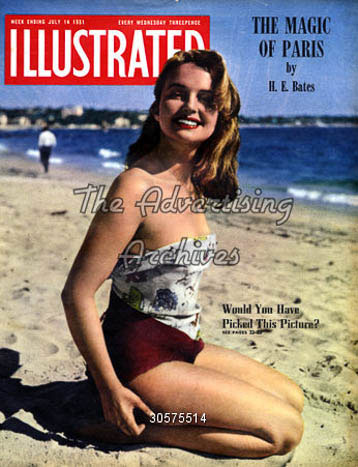Pin-ups
Photos of people in the news were very much in demand when I started as a photographer in the early Fifties. However, there also was a need for glamour pictures. I got instructions on the kind of pictures they wanted. The American National Enquirer, for instance, sent copies of pictures they used and wrote “As you can see, we prefer the bikini swimsuit and the type of figure that fills it well.” I read articles telling me how to get the best pictures. They talked about model lists, which had to be studied so as to choose the right model who would suit the planned project.
They gave indications of the props that one should bring along to take a livelier picture, such as a piece of bric-a-brac, which would break the monotonous sand and stimulate the imagination, or a guitar to break a drab stretch of beach and bring an unusual touch to the picture. Certain elements like natural props at a harbour, for instance, should be separated from the rest and used as suggestive elements.
The costuming of the model should be appropriate to her actions. Her hair should be lacquered down or left free to blow in the right direction. A makeup kit should be brought just in case the model’s makeup needed repair. Information was given that Max Factor’s pancake N25 was very good for black and white photos, while the 3N could be used for colour pictures, etc. All this advice and the well-meant instructions were unfortunately not of much use to me, as most of my work could not be programmed or prearranged but had to be done by improvisation.
In those days, doing glamour photographs was part of a photographer’s routine. Pretty girls were still pleased to get their picture published in a newspaper or magazine, but it was not possible to choose models from a list. No modelling agency existed on the Côte d’Azur, so I had to find the attractive girls myself.
The obvious place to notice pretty girls was, of course, on the beach. Whenever I saw a girl who in all probability would photograph well, I just went up to her and politely asked if she would mind having her photograph taken. The girls usually accepted willingly, however there was no question of looking for the appropriate background or asking them to change their hairstyle or costume. I had to make the best of the existing situation. I also followed the beauty contests that were frequently staged on the Riviera, where the “Reine de la Côte d’Azur”, “Reine de Nice” and other queens were elected. When the girls were really pretty, I would try and photograph them some other day. I always looked out for lively girls with a natural charm, graceful movements and a lovely, heart-warming smile, not the “say cheese” kind of smile.
I had the chance of meeting one exceptional girl, Greta Thysegen from Denmark. She had come to Nice for a holiday in the sun. I noticed her walking along the Promenade des Anglais. It was with a set of photographs of Greta that I made my first break into the realm of cover photos for magazines. The magazine Illustrated, one of the great picture magazines in England, used a cover and a set of photos and organized a readers’ contest to choose the most popular pose.

I photographed a great number of very attractive girls; none were professional photo models. Many became film actresses, others married famous men – the American model Gregg Sherwood married Horace Dodge of the motorcars; the beauty queen Myriam Bru wed the German actor Horst Buchholz; the French fashion model Eliette Mouret became the wife of the famous conductor Herbert von Karajan. Glamour photography could be quite useful – very often after having tried in vain to find a personality interesting to the press, one could be practically sure to get at least some pictures of a pretty girl spotted on the beach. When I looked for photographic material for a film project about pin-ups, l was amazed to realize that most of the pictures I took in the middle of this century, forty or fifty years ago, could have been taken nowadays. The girls I photographed would certainly draw attention, not because they look old-fashioned, but because of their beauty and charm. Their swimsuits or beach outfit, their hairstyle, their makeup, nothing seems to differ much from the present fashion. Of course the beaches have changed – lonely spots along the coast are certainly rare nowadays. If by comparison one remembers photographs of young ladies taken at some fashionable summer resort at the beginning of this century, the difference with the girls I photographed in the Fifties seems enormous. One has in mind pictures of ladies, practically fully dressed, carrying a pretty sunshade, dipping their foot into the sea at the water’s edge. If those photos would be compared with my pictures of the Fifties, nobody could possibly mistake the period.
